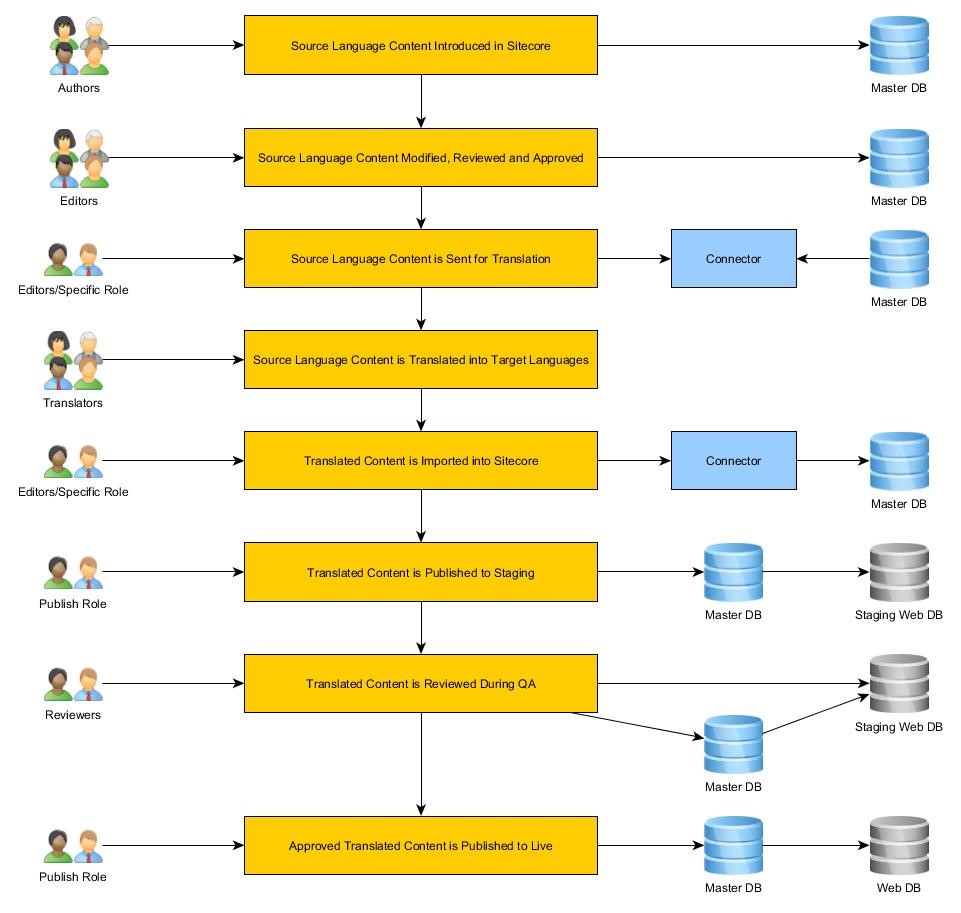The Importance of a Workflow in Sitecore Localization Projects
If you’re thinking about localizing your Sitecore website content into one or more languages, you may have asked yourself several questions like: should I make changes to the website while translations are taking place? How do I handle website updates once the website is translated? It’s important to have a workflow in place before starting a Sitecore localization project so you can correctly identify the answers to these questions and any others that may arise.
Sitecore’s content management system (CMS) provides useful features that help when creating and managing multilingual websites. However, there are some aspects outside the scope of Sitecore that need to be considered. These include things like when updates to the source language content will be applied, when they will be sent for translation or how often you will update content in the target languages. To have an answer for each of these questions, it’s important to define a workflow.
From a high-level perspective, you could think of a localization project workflow with the following basic steps:
- The source language content is introduced in Sitecore. This will be usually done by authors.
- The source language content is reviewed, modified and approved. This will usually be done by editors.
- The source language content is sent for translation. If you’re using a tool like a translation connector, then you could define a role with the permissions to send content for translation.
- The content is translated into the target languages. Depending on the amount of content, this could take one or more days. On average, one human translator can translate approximately 2000 words per day.
- The translated content is imported into Sitecore.
- The imported content is published to a staging server.
- The imported content is reviewed during a QA round. You could have the reviewers from the translation agency do the QA and/or use in-house reviewers. The necessary changes are applied in the content and then published to staging.
- The approved content is published to a live server.

The workflow described above represents an ideal sequence of steps, but there could be some situations that could drive this workflow in a different way. Let’s think about some scenarios and how you can address them.
The Source Language Content is Not Ready
The basic workflow described above assumes that you have the source language content ready to be sent for translation. This assumption is not always true.
You could be in a situation where part of the source language content is already in Sitecore and the rest is not. In this case, if you have enough time, you could finish inputting the source language content and then export everything for translation. Another approach could be to split the content in logical parts of the website, like a section, a page or a component and then send those parts for translation individually. By following this approach, you’ll require more time for QA and l10n engineering, since it’s more time consuming to work on separate batches than working on a single batch with all the content.
The Source Language Content Changes After Export
This is one of the most common scenarios. Essentially, if you change an item or component in Sitecore while it’s under translation, then it’s highly probable that there will be issues when the translations are imported back.
One of the situations could be that the source language content is different on certain items so when doing the QA the reviewers will notice the content mismatch. Then, the updated items will need to be sent for translation. This back and forth will introduce additional time for translation, QA and l10n engineering.
Another situation could be that the structure of a component, page or even of the site changes after all its items were sent for translation. This could result into untranslated pieces of content displayed in the website. Similar to the previous situation, this one will require sending content for translation again and, consequently, introducing delays in the delivery and increasing time for translation, QA and l10n engineering.
Always keep in mind that it’s important to do a content freeze while translations are taking place to avoid rework and delays.
The Website is Fully Translated but Requires Updates
You could be in a situation where your website is already translated but some changes need to be introduced. If the changes are needed occasionally, then you can add them in the source language for each item and export the corresponding items for translation using a connector.
If the changes are needed more often, for example new blog entries that will be added each week or month, then you can think about defining weekly or monthly projects.
Conclusion
Sitecore provides many nice features to handle localization, but there are many aspects to consider before starting a localization project. It’s difficult to imagine all the possible scenarios that could arise, but it’s important to devote some time to consider the current status and define a basic workflow and some alternative actions just in case they are needed.
